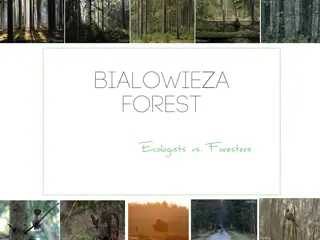The Legend of Sherwood Forest: From Royal Hunting Reserve to Nature Reserve
Sherwood Forest, once a royal hunting reserve in the 10th Century, is renowned for its association with the legendary figure Robin Hood. The forest provided cover for both hunting and outlaws, eventually becoming a nature reserve attracting millions of visitors annually. Despite its reduced size from exploitation, Sherwood Forest retains its historical significance and ecological importance.
Download Presentation

Please find below an Image/Link to download the presentation.
The content on the website is provided AS IS for your information and personal use only. It may not be sold, licensed, or shared on other websites without obtaining consent from the author.If you encounter any issues during the download, it is possible that the publisher has removed the file from their server.
You are allowed to download the files provided on this website for personal or commercial use, subject to the condition that they are used lawfully. All files are the property of their respective owners.
The content on the website is provided AS IS for your information and personal use only. It may not be sold, licensed, or shared on other websites without obtaining consent from the author.
E N D
Presentation Transcript
What is skimming? Skimming is used to find out what the text is about to get the gist . Skimming is a technique that can help you: read a whole text quickly and under pressure decide if the text is interesting / useful and whether you should read it in more detail You can use the skimming technique when you want to identify the main ideas in the text.
How to skim? Read the title, subtitles and subheadings to find out what the text is about. Look at the illustrations to give you more information about the topic. Read the first and last sentence of each paragraph. Don t read every word or every sentence. Let your eyes skim over the text and look out for key words.
Once an area of dense woodland and heathland stretching over 30 miles from Nottingham to Worksop, Sherwood Forest was established as a royal hunting reserve in the 10th Century. This meant that it was illegal for anyone but Norman royalty and their chosen guests to hunt amongst the lands. The sandy heath and thickets of Sherwood provided ideal cover for hunting deer and hunting with falcons. They also provided cover for outcasts and outlaws who were not welcome in medieval British society. It was during this time the legend of Robin Hood also emerged. Portrayed as a fearless and heroic rebel, Robin Hood and his band of Merry Men were said to have stolen from the rich to feed the poor. The link to royalty continued as parts of the forest eventually came under the ownership of four noble families and became known as TheDukeries . Today Sherwood Forest is much reduced in size due to years of exploitation. However, it has now been designated a nature reserve and attracts over a million visitors each year. One of the biggest
Once an area of dense woodland and heathland stretching over 30 miles from Nottingham to Worksop, Sherwood Forest was established as a royal hunting reserve in the 10th Century. This meant that it was illegal for anyone but Norman royalty and their chosen guests to hunt amongst the lands. The sandy heath and thickets of Sherwood provided ideal cover for hunting deer and hunting with falcons. They also provided cover for outcasts and outlaws who were not welcome in medieval British society. It was during this time the legend of Robin Hood also emerged. Portrayed as a fearless and heroic rebel, Robin Hood and his band of Merry Men were said to have stolen from the rich to feed the poor. The link to royalty continued as parts of the forest eventually came under the ownership of four noble families and became known as TheDukeries . Today Sherwood Forest is much reduced in size due to years of exploitation. However, it has now been designated a nature reserve and attracts over a million visitors each year. One of the biggest
Once an area of dense woodland and heathland stretching over 30 miles from Nottingham to Worksop, Sherwood Forest was established as a royal hunting reserve in the 10th Century. This meant that it was illegal for anyone but Norman royalty and their chosen guests to hunt amongst the lands. The sandy heath and thickets of Sherwood provided ideal cover for hunting deer and hunting with falcons. They also provided cover for outcasts and outlaws who were not welcome in medieval British society. It was during this time the legend of Robin Hood also emerged. Portrayed as a fearless and heroic rebel, Robin Hood and his band of Merry Men were said to have stolen from the rich to feed the poor. The link to royalty continued as parts of the forest eventually came under the ownership of four noble families and became known as TheDukeries . Today Sherwood Forest is much reduced in size due to years of exploitation. However, it has now been designated a nature reserve and attracts over a million visitors each year. One of the biggest
Once an area of dense woodland and heathland stretching over 30 miles from Nottingham to Worksop, Sherwood Forest was established as a royal hunting reserve in the 10th Century. This meant that it was illegal for anyone but Norman royalty and their chosen guests to hunt amongst the lands. The sandy heath and thickets of Sherwood provided ideal cover for hunting deer and hunting with falcons. They also provided cover for outcasts and outlaws who were not welcome in medieval British society. It was during this time the legend of Robin Hood also emerged. Portrayed as a fearless and heroic rebel, Robin Hood and his band of Merry Men were said to have stolen from the rich to feed the poor. The link to royalty continued as parts of the forest eventually came under the ownership of four noble families and became known as TheDukeries . Today Sherwood Forest is much reduced in size due to years of exploitation. However, it has now been designated a nature reserve and attracts over a million visitors each year. One of the biggest
1 Minute Skimming Challenge The attacker was said to be tall and thin, with pointed ears and fiery eyes, and covered in a long cloak. He tore at his victims' clothes and ripped their flesh with hands that felt like iron. When he escaped, he did not run; he leaped away. Those who saw his feet swore he had springs in his boot heels. At first, the authorities had a hard time believing what victims were telling them. But by January 1838 so many Londoners had seen the figure that the Lord Mayor formed a special team to capture "Spring Heeled Jack. In one especially notorious incident, he tried to snatch 18-year-old Jane Alsop right out of her own house. According to the London Times (February 22, 1838), he "presented a most hideous and frightful appearance, and vomited forth a quantity of blue and white flame from his mouth, and his eyes resembled red balls of fire The young woman was saved by family members. One day in 1845, in full view of frightened onlookers, Jack was reported to have thrown a woman, rumoured to be a prostitute, from a bridge; she drowned in the open sewer below. Sightings of a comparable figure were recorded elsewhere in England in 1877. In 1904 more than 100 residents of Everton in Liverpool saw a man in a flowing cloak and black boots making great leaps over streets and rooftops. Who -- or what -- was Spring-heel Jack? Some suspected that he was a rowdy nobleman, Henry, Marquis of Waterford, who died in 1859. Doubters countered that Jack-like leaps are physically impossible. During World War II German paratroopers who put springs in their boot heels got broken ankles for their efforts. In July 1953, three Houston residents reported seeing a tall, bounding figure "wearing a black cape, skintight pants, and quarter length boots " For a few minutes he remained
Skimming for Meaning Challenge Twas brillig, and the slithy toves Did gyre and gimble in the wabe: All mimsy were the borogoves, And the mome raths outgrabe. Beware the Jabberwock, my son! The jaws that bite, the claws that catch! Beware the Jubjub bird, and shun The frumious Bandersnatch! And, as in uffish thought he stood, The Jabberwock, with eyes of flame, Came whiffling through the tulgey wood, And burbled as it came! He took his vorpal sword in hand; Long time the manxome foe he sought So rested he by the Tumtum tree And stood awhile in thought. One, two! One, two! And through and through The vorpal blade went snicker-snack! He left it dead, and with its head He went galumphing back. And hast thou slain the Jabberwock? Come to my arms, my beamish boy! O frabjous day! Callooh! Callay! He chortled in his joy. Twas brillig, and the slithy toves
Skimming for Meaning Challenge It was four o clock in the afternoon, and the slimy creatures that looked a strange mix of badger, lizard and corkscrew ran around in circles, scratching themselves, and digging holes in a grass plot surrounding a sundial. The thin, shabby-looking birds were miserable and flimsy, and the green pigs, far from home, made a noise between bellowing and whistling, with a kind of sneeze in the middle. As he stood, a strange gruff but hushed voice was heard, then the Jabberwock, its eyes full of fire, came creeping through the thick, dense and dark wood, uttering a noise that was a horrific mix of bleating, murmuring and singing. Beware the jabberwock, my son! The jaws that bite, the claws that catch! Beware the desperate, passion-locked bird, and shun the fuming, furious bandersnatch! One, two! One, two! Through and through, the blade went, snicker-snack! He left it dead, and with its head, he triumphantly returned with a trot and a gallop. He took his long sword in hand. For a long time, he hunted for the fearsome and muscly enemy. Eventually he rested by the Tum-Tum tree, and stood awhile in thought. Have you killed the jabberwock? Come to my arms, my radiantly beaming boy! Oh fair, fabulous, joyous day! Woo-hoo! Wa-hay! He chuckled and snorted in his joy. It was four o clock in the afternoon, and the slimy creatures that looked a strange mix of badger, lizard and corkscrew ran around in circles, scratching themselves, and digging holes in a grass plot surrounding a sundial. The thin, shabby-looking birds were miserable and flimsy, and the green pigs, far from home,























